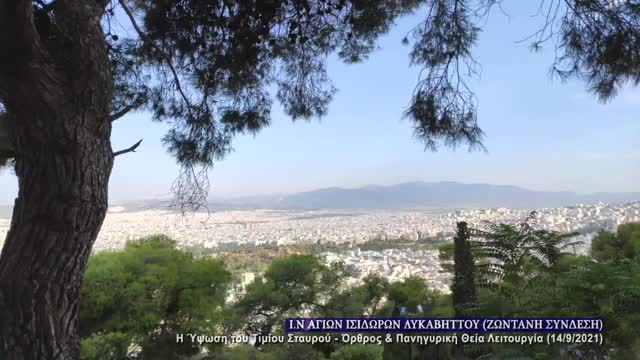Premium Only Content

September 14, 2021 | Elevation of the Life-Giving Cross | Greek Orthodox Divine Liturgy Live Steam
Saint Helen, the mother of Saint Constantine the Great, when she was already advanced in years, undertook, in her great piety, the hardships of a journey to Jerusalem in search of the cross, about the year 325. A temple to Aphrodite had been raised up by the Emperor Hadrian upon Golgotha, to defile and cover with oblivion the place where the saving Passion had been suffered. The venerable Helen had the statue of Aphrodite destroyed, and the earth removed, revealing the Tomb of our Lord, and three crosses. Of these, it was believed that one must be that of our Lord, the other two of the thieves crucified with Him; but Saint Helen was at a loss which one might be the Wood of our salvation. At the inspiration of Saint Macarius, Archbishop of Jerusalem, a lady of Jerusalem, who was already at the point of death from a certain disease, was brought to touch the crosses, and as soon as she came near to the Cross of our Lord, she was made perfectly whole. Consequently, the precious Cross was lifted on high by Archbishop Macarius of Jerusalem; as he stood on the ambo, and when the people beheld it, they cried out, "Lord have mercy." It should be noted that after its discovery, a portion of the venerable Cross was taken to Constantinople as a blessing. The rest was left in Jerusalem in the magnificent church built by Saint Helen, until the year 614. At that time, the Persians plundered Palestine and took the Cross to their own country (see Jan. 22, Saint Anastasius the Persian). Late, in the year 628, Emperor Heraclius set out on a military campaign, retrieved the Cross, and after bringing it to Constantinople, himself escorted it back to Jerusalem, where he restored it to its place.
The Elevation of the Venerable and Life-Giving Cross;
Matins Gospel : John 12:28-36
The Lord said, “Father, glorify your name.” Then a voice came from heaven, “I have glorified it, and I will glorify it again.” The crowd standing by heard it and said that it had thundered. Others said, “An angel has spoken to him.” Jesus answered, “This voice has come for your sake, not for mine. Now is the judgment of this world, now shall the ruler of this world be cast out: and I, when I am lifted up from the earth, will draw all men to myself.” He said this to show by what death he was to die. The crowd answered him, “We have heard from the law that the Christ remains for ever. How can you say that the Son of man must be lifted up? Who is this Son of man?” Jesus said to them, “The light is with you for a little longer. Walk while you have the light, lest the darkness overtake you; he who walks in darkness does not know where he goes. While you have the light, believe in the light, that you may become sons of light.”
Gospel : John 19:6-11, 13-20, 25-28, 30
At that time, when the chief priests and the officers saw him, they cried out, “Crucify him, crucify him!” Pilate said to them, “Take him yourselves and crucify him, for I find no crime in him.” The Jews answered him, “We have a law, and by that law he ought to die, because he has made himself the Son of God.”
When Pilate heard these words, he was the more afraid; he entered the praetorium again and said to Jesus, “Where are you from?” But Jesus gave no answer. Pilate therefore said to him, “You will not speak to me? Do you not know that I have power to release you, and power to crucify you?” Jesus answered him, “You would have no power over me unless it had been given you from above; therefore he who delivered me to you has the greater sin.” When Pilate heard these words, he brought Jesus out and sat down on the judgment seat at a place called the Pavement, and in Hebrew, Gabbatha. Now it was the day of Preparation of the Passover; it was about the sixth hour. He said to the Jews, “Behold your King!” They cried out, “Away with him, away with him, crucify him!” Pilate said to them, “Shall I crucify your King?” The chief priests answered, “We have no king but Caesar.” Then he handed him over to them to be crucified. So they took Jesus, and he went out, bearing his own cross, to the place called the place of a skull, which is called in Hebrew Golgotha. There they crucified him, and with him two others, one on either side, and Jesus between them. Pilate also wrote a title and put it on the cross; it read, “Jesus of Nazareth, the King of the Jews.” Many of the Jews read this title, for the place where Jesus was crucified was near the city; and it was written in Hebrew, in Latin, and in Greek.
But standing by the cross of Jesus were his mother, and his mother’s sister, Mary the wife of Clopas, and Mary Magdalene. When Jesus saw his mother, and the disciple whom he loved standing near, he said to his mother, “Woman, behold your son!” Then he said to the disciple, “Behold your mother!” And from that hour the disciple took her to his own home. Then when Jesus had received the vinegar, he said, “It is finished”; and he bowed his head and gave up his spirit.
#Orthodox #DivineLiturgy #Greek #Orthodoxy
-
 2:27:34
2:27:34
Greek Orthodox Church St. Isidoroi, Athens, Greece
2 years agoNovember 4, 2022, St. George Karslidis the Confessor | Greek Orthodox Divine Liturgy
90 -
 1:35:04
1:35:04
Winston Marshall
1 day ago“This Wasn’t Accidental!” Maajid Nawaz SPEAKS OUT on R*PE Gangs and The REAL Cover-Up
3K10 -
 23:46
23:46
barstoolsports
1 hour agoSurviving Barstool Drama Spills Over Into The Office | Stool Scenes
2671 -
 LIVE
LIVE
Shield_PR_Gaming
2 hours ago01/18/25. Let's chill with MMORPG and then some shooters!! Read Description! You know you want to!!
324 watching -
 1:09:39
1:09:39
Tactical Advisor
1 hour agoTrump Inauguration & New Gun Releases | Vault Room Live Stream 014
4.11K -
 11:27
11:27
Adam Does Movies
14 hours ago $3.10 earnedWolf Man Movie Review - Does It Bite?
24.5K7 -
 11:57
11:57
inspirePlay
18 hours ago $6.33 earnedLongest Drive Wins! Elite Long Drivers Battle in Par 4 Elimination
43.5K5 -
 8:44
8:44
RTT: Guns & Gear
20 hours ago $3.03 earnedStreamlight TLR RM2 Laser - G | The Best PCC Light
25.7K1 -
 36:38
36:38
Athlete & Artist Show
1 month ago $2.46 earnedNCAA Hockey Was A Joke, TNT Hockey Panel Is The Best In Sports
25.7K2 -
 1:00:08
1:00:08
Trumpet Daily
23 hours ago $4.70 earnedBanning Mystery of the Ages - Trumpet Daily | Jan. 17, 2025
15.1K18